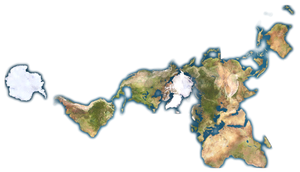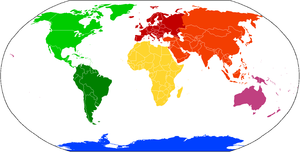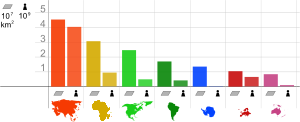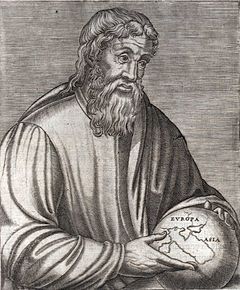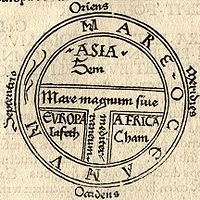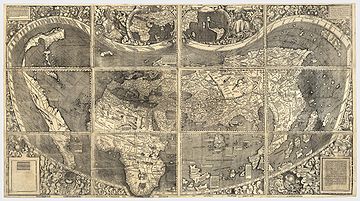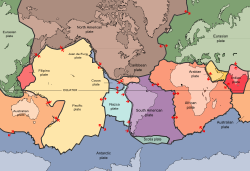
Continent
About this schools Wikipedia selection
Arranging a Wikipedia selection for schools in the developing world without internet was an initiative by SOS Children. SOS mothers each look after a a family of sponsored children.
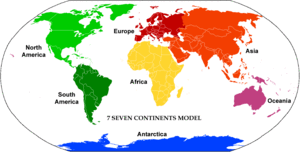
A continent is one of several large landmasses on Earth. They are generally identified by convention rather than any strict criteria, but seven areas are commonly regarded as continents – they are (from largest in size to smallest): Asia, Africa, North America, South America, Antarctica, Europe, and Australia.
Plate tectonics is the geological process and study of the movement, collision and division of continents, earlier known as continental drift.
The term "the Continent" (capitalized), used predominantly in the European isles and peninsulas, such as the British Isles, Sardinia, Sicily and the Scandinavian Peninsula, means mainland Europe, although it can also mean Asia when said in Japan.
Definitions and application
"Continents are understood to be large, continuous, discrete masses of land, ideally separated by expanses of water." However, many of the seven most commonly recognized continents are identified by convention rather than adherence to the ideal criterion that each be a discrete landmass, separated by water from others. Likewise, the criterion that each be a continuous landmass is often disregarded by the inclusion of the continental shelf and oceanic islands. The Earth's major landmasses are washed upon by a single, continuous World Ocean, which is divided into a number of principal oceanic components by the continents and various geographic criteria.
Extent of continents
The narrowest meaning of continent is that of a continuous area of land or mainland, with the coastline and any land boundaries forming the edge of the continent. In this sense the term continental Europe is used to refer to mainland Europe, excluding islands such as Great Britain, Ireland, and Iceland, and the term continent of Australia may refer to the mainland of Australia, excluding Tasmania. Similarly, the continental United States refers to the 48 contiguous United States in central North America and may include Alaska in the northwest of the continent (both separated by Canada), while excluding Hawaii in the middle of the Pacific Ocean.
From the perspective of geology or physical geography, continent may be extended beyond the confines of continuous dry land to include the shallow, submerged adjacent area (the continental shelf) and the islands on the shelf ( continental islands), as they are structurally part of the continent. From this perspective the edge of the continental shelf is the true edge of the continent, as shorelines vary with changes in sea level. In this sense the islands of Great Britain and Ireland are part of Europe, and Australia and the island of New Guinea together form a continent ( Australia-New Guinea).
As a cultural construct, the concept of a continent may go beyond the continental shelf to include oceanic islands and continental fragments. In this way, Iceland is considered part of Europe and Madagascar part of Africa. Extrapolating the concept to its extreme, some geographers take Australia, New Zealand and all the islands of Oceania (or sometimes Australasia) to be equivalent to a continent, allowing the entire land surface of the Earth to be divided into continents or quasi-continents.
Separation of continents
The ideal criterion that each continent be a discrete landmass is commonly disregarded in favour of more arbitrary, historical conventions. Of the seven most commonly recognized continents, only Antarctica and Australia are separated from other continents.
Several continents are defined not as absolutely distinct bodies but as "more or less discrete masses of land". Asia and Africa are joined by the Isthmus of Suez, and North and South America by the Isthmus of Panama. Both these isthmuses are very narrow in comparison with the bulk of the landmasses they join, and both are transected by artificial canals (the Suez Canal and Panama Canal, respectively) which effectively separate these landmasses.
The division of the landmass of Eurasia into the continents of Asia and Europe is an anomaly, as no sea separates them. The distinction is maintained for historical and cultural reasons. An alternative view is that Eurasia is a single continent, one of six continents in total. This view is held by some geographers and is preferred in Russia (which spans Asia and Europe).
North America and South America are now treated as separate continents in much of Western Europe, India, China, and most native English-speaking countries, such as the United States, Canada, Australia, and New Zealand. Furthermore, the concept of two American continents is prevalent in much of Asia. However, in earlier times they were viewed as a single continent known as America or, to avoid ambiguity with the United States of America, as the Americas. However, the plurality of this last term suggests that even in these "earlier times" some considered the New World (the Americas) as two separate continents. North and South America are viewed as a single continent, one of six in total, in some parts of Europe, and much of Latin America.
When continents are defined as discrete landmasses, embracing all the contiguous land of a body, then Asia, Europe and Africa form a single continent known by various names such as Afro-Eurasia. This produces a four-continent model consisting of Afro-Eurasia, the Americas, Antarctica and Australia.
When sea levels were lower during the Pleistocene ice age, greater areas of continental shelf were exposed as dry land, forming land bridges. At this time Australia-New Guinea was a single, continuous continent. Likewise North America and Asia were joined by the Bering land bridge. Other islands such as Great Britain were joined to the mainlands of their continents. At that time there were just three discrete continents: Afro-Eurasia-America, Antarctica, and Australia-New Guinea.
Number of continents
There are numerous ways of distinguishing the continents;
| Models | ||||||||
|---|---|---|---|---|---|---|---|---|
|
|
||||||||
| 7 continents |
|
|
|
|
|
|
|
|
| 6 continents |
|
|
|
|
|
|
||
| 6 continents |
|
|
|
|
|
|
||
| 5 continents |
|
|
|
|
|
|||
The seven-continent model is usually taught in Western Europe, Northern Europe, Central Europe, Southeastern Europe, China and most English-speaking countries. The six-continent combined-Eurasia model is preferred by the geographic community, Russia, Eastern Europe, and Japan. The six-continent combined-America model is taught in Latin America, Iran and some parts of Europe including Iberian Peninsula and Greece. This model may be taught to include only the five inhabited continents (excluding Antarctica) — as depicted in the Olympic logo.
The names Oceania or Australasia are sometimes used in place of Australia. For example, the Atlas of Canada names Oceania, as does the model taught in Latin America and Iberia.
Area and population
| Continent | Area (km²) | Approx. population 2002 |
Percent of total population |
Density People per square kilometre |
|---|---|---|---|---|
| Asia | 43,810,000 | 3,800,000,000 | 60% | 86.7 |
| Africa | 30,370,000 | 922,011,000 | 14% | 29.3 |
| Americas | 42,330,000 | 890,000,000 | 14% | 20.9 |
| North America | 24,490,000 | 515,000,000 | 8% | 21.0 |
| South America | 17,840,000 | 371,000,000 | 6% | 20.8 |
| Antarctica | 13,720,000 | 1,000 | 0.00002% | 0.00007 |
| Europe | 10,180,000 | 710,000,000 | 11% | 69.7 |
| Oceania | 9,010,000 | 33,552,994 | 0.6% | 3.7 |
| Australia-New Guinea | 8,500,000 | 30,000,000 | 0.5% | 3.5 |
| Australia mainland | 7,600,000 | 21,000,000 | 0.3% | 2.8 |
The total land area of all continents is 148,647,000 km², or approximately 29.1% of earth's surface (510,065,600 km2).
Other divisions
Certain parts of continents are recognized as subcontinents, particularly those on different tectonic plates to the rest of the continent. The most notable examples are the Indian subcontinent and the Arabian Peninsula. Greenland, on the North American Plate, is sometimes referred to as a subcontinent. Where America is viewed as a single continent, it is divided into two subcontinents (North America and South America) or various regions.
Some areas of continental crust are largely covered by the sea and may be considered submerged continents. Notable examples are Zealandia, emerging from the sea primarily in New Zealand and New Caledonia, and the almost completely submerged Kerguelen continent in the southern Indian Ocean.
Some islands lie on sections of continental crust that have rifted and drifted apart from a main continental landmass. While not considered continents because of their relatively small size, they may be considered microcontinents. Madagascar, the largest example, is usually considered part of Africa but has been referred to as "the eighth continent".
History of the concept
Early concepts of the Old World continents
The first distinction between continents was made by ancient Greek mariners who gave the names Europe and Asia to the lands on either side of the waterways of the Aegean Sea, the Dardanelles strait, the Sea of Marmara, the Bosphorus strait and the Black Sea. The names were first applied just to lands near the coast and only later extended to include the hinterlands. But the division was only carried through to the end of navigable waterways and "... beyond that point the Hellenic geographers never succeeded in laying their finger on any inland feature in the physical landscape that could offer any convincing line for partitioning an indivisible Eurasia ..."
Ancient Greek thinkers subsequently debated whether Africa (then called Libya) should be considered part of Asia or a third part of the world. Division into three parts eventually came to predominate. From the Greek viewpoint, the Aegean Sea was the centre of the world; Asia lay to the east, Europe to the west and north and Africa to the south. The boundaries between the continents were not fixed. Early on, the Europe-Asia boundary was taken to run from the Black Sea along the Rioni River (known then as the Phasis) in Georgia. Later it was viewed as running from the Black Sea through Kerch Strait, the Sea of Azov and along the Don River (known then as the Tanais) in Russia. The boundary between Asia and Africa was generally taken to be the Nile River. Herodotus in the fifth century BC, however, objected to the unity of Egypt being split into Asia and Africa ("Libya") and took the boundary to lie along the western border of Egypt, regarding Egypt as part of Asia. He also questioned the division into three of what is really a single landmass, a debate that continues nearly two and a half millennia later.
Eratosthenes, in the third century BC, noted that some geographers divided the continents by rivers (the Nile and the Don), thus considering them "islands". Others divided the continents by isthmuses, calling the continents "peninsulas". These latter geographers set the border between Europe and Asia at the isthmus between the Black Sea and the Caspian Sea, and the border between Asia and Africa at the isthmus between the Red Sea and the mouth of Lake Bardawil on the Mediterranean Sea.
Through the Roman period and the Middle Ages, a few writers took the Isthmus of Suez as the boundary between Asia and Africa, but most writers continued to take it to be the Nile or the western border of Egypt (Gibbon). In the Middle Ages the world was portrayed on T and O maps, with the T representing the waters dividing the three continents. By the middle of the eighteenth century, "the fashion of dividing Asia and Africa at the Nile, or at the Great Catabathmus [the boundary between Egypt and Libya] farther west, had even then scarcely passed away".
European discovery of the Americas
Christopher Columbus sailed across the Atlantic Ocean to the West Indies in 1492, sparking a period of European exploration of the Americas. But despite four voyages to the Americas, Columbus never believed he had reached a new continent – he always thought it was part of Asia.
In 1501, Amerigo Vespucci and Gonçalo Coelho attempted to sail around the southern end of the Asian mainland into the Indian Ocean. On reaching the coast of Brazil, they sailed a long way south along the coast of South America, confirming that this was a land of continental proportions and that it extended much further south than Asia was known to. On return to Europe, an account of the voyage, called Mundus Novus ("New World"), was published under Vespucci’s name in 1502 or 1503, although it seems that it had additions or alterations by another writer. Regardless of who penned the words, Mundus Novus attributed Vespucci with saying, "I have discovered a continent in those southern regions that is inhabited by more numerous people and animals than our Europe, or Asia or Africa", the first known explicit identification of part of the Americas as a continent like the other three.
Within a few years the name "New World" began appearing as a name for South America on world maps, such as the Oliveriana (Pesaro) map of around 1504–1505. Maps of this time though still showed North America connected to Asia and showed South America as a separate land.
In 1507 Martin Waldseemüller published a world map, Universalis Cosmographia, which was the first to show North and South America as separate from Asia and surrounded by water. A small inset map above the main map explicitly showed for the first time the Americas being east of Asia and separated from Asia by an ocean, as opposed to just placing the Americas on the left end of the map and Asia on the right end. In the accompanying book Cosmographiae Introductio, Waldseemüller noted that the earth is divided into four parts, Europe, Asia, Africa and the fourth part which he named "America" after Amerigo Vespucci's first name. On the map, the word "America" was placed on part of South America.
The word continent
From the 1500s the English noun continent was derived from the term continent land, meaning continuous or connected land and translated from the Latin terra continens. The noun was used to mean "a connected or continuous tract of land" or mainland. It was not applied only to very large areas of land — in the 1600s, references were made to the continents (or mainlands) of Kent, Ireland and Wales and in 1745 to Sumatra. The word continent was used in translating Greek and Latin writings about the three "parts" of the world, although in the original languages no word of exactly the same meaning as continent was used.
While continent was used on the one hand for relatively small areas of continuous land, on the other hand geographers again raised Herodotus’s query about why a single large landmass should be divided into separate continents. In the mid 1600s Peter Heylin wrote in his Cosmographie that "A Continent is a great quantity of Land, not separated by any Sea from the rest of the World, as the whole Continent of Europe, Asia, Africa." In 1727 Ephraim Chambers wrote in his Cyclopædia, "The world is ordinarily divided into two grand continents: the old and the new." And in his 1752 atlas, Emanuel Bowen defined a continent as "a large space of dry land comprehending many countries all joined together, without any separation by water. Thus Europe, Asia, and Africa is one great continent, as America is another." However, the old idea of Europe, Asia and Africa as "parts" of the world ultimately persisted with these being regarded as separate continents.
Beyond four continents
From the late 18th century some geographers started to regard North America and South America as two parts of the world, making five parts in total. Overall though the fourfold division prevailed well into the 19th century.
Europeans discovered Australia in 1606 but for some time it was taken as part of Asia. By the late 18th century some geographers considered it a continent in its own right, making it the sixth (or fifth for those still taking America as a single continent). In 1813 Samuel Butler wrote of Australia as " New Holland, an immense island, which some geographers dignify with the appellation of another continent" and the Oxford English Dictionary was just as equivocal some decades later.
Antarctica was sighted in 1820 and described as a continent by Charles Wilkes on the United States Exploring Expedition in 1838, the last continent to be identified, although a great "Antarctic" (antipodean) landmass had been anticipated for millennia. An 1849 atlas labelled Antarctica as a continent but few atlases did so until after World War II.
From the mid-19th century, United States atlases more commonly treated North and South America as separate continents, while atlases published in Europe usually considered them one continent. However, it was still not uncommon for United States atlases to treat them as one continent up until World War II. The Olympic flag, devised in 1913, has five rings representing the five inhabited, participating continents, with America being treated as one continent and Antarctica not included.
From the 1950s, most United States geographers divided America in two — consistent with modern understanding of geology and plate tectonics. With the addition of Antarctica, this made the seven-continent model. However, this division of America never appealed to Latin America, which saw itself spanning an America that was a single landmass, and there the conception of six continents remains, as it does in scattered other countries.
However, in recent years, there has been a push for Europe and Asia—traditionally considered two continents—to be considered one single continent, dubbed " Eurasia" - consistent with modern understanding of geology and plate tectonics. In this model, the world is divided into six continents (if North America and South America are considered separate continents).
Geology
Geologists use the term continent in a different manner than geographers, where a continent is defined by continental crust: a platform of metamorphic and igneous rock, largely of granitic composition. Some geologists restrict the term 'continent' to portions of the crust built around stable Precambrian "shield", typically 1.5 to 3.8 billion years old, called a craton. The craton itself is an accretionary complex of ancient mobile belts (mountain belts) from earlier cycles of subduction, continental collision and break-up from plate tectonic activity. An outward-thickening veneer of younger, minimally deformed sedimentary rock covers much of the craton. The margins of geologic continents are characterized by currently-active or relatively recently active mobile belts and deep troughs of accumulated marine or deltaic sediments. Beyond the margin, there is either a continental shelf and drop off to the basaltic ocean basin or the margin of another continent, depending on the current plate-tectonic setting of the continent. A continental boundary does not have to be a body of water. Over geologic time, continents are periodically submerged under large epicontinental seas, and continental collisions result in a continent becoming attached to another continent. The current geologic era is relatively anomalous in that so much of the continental areas are "high and dry" compared to much of geologic history.
Some argue that continents are accretionary crustal "rafts" which, unlike the denser basaltic crust of the ocean basins, are not subjected to destruction through the plate tectonic process of subduction. This accounts for the great age of the rocks comprising the continental cratons. By this definition, Europe could be regarded as a distinct continental mass from the rest of Eurasia because it has a separate ancient shield area. A younger mobile belt (the Ural Mountains) marks the boundary between Europe and the block to the east.
There are many microcontinents that are built of continental crust but do not contain a craton. Some of these are fragments of Gondwanaland or other ancient cratonic continents: Zealandia, which includes New Zealand and New Caledonia; Madagascar; the northern Mascarene Plateau, which includes the Seychelles; etc. Other islands, such as several in the Caribbean Sea, are composed largely of granitic rock as well, but all continents contain both granitic and basaltic crust, and there is no clear boundary as to which islands would be considered microcontinents under such a definition. The Kerguelen Plateau, for example, is largely volcanic, but is associated with the breakup of Gondwanaland and is considered to be a microcontinent, whereas volcanic Iceland and Hawaii are not. The British Isles, Sri Lanka, Borneo, and Newfoundland are margins of the Laurasian continent which are only separated by inland seas flooding its margins.
Plate tectonics offers yet another way of defining continents. Today, Europe and most of Asia comprise the unified Eurasian Plate which is approximately coincident with the geographic Eurasian continent excluding India, Arabia, and far eastern Russia. India contains a central shield, and the geologically recent Himalaya mobile belt forms its northern margin. North America and South America are separate continents, the connecting isthmus being largely the result of volcanism from relatively recent subduction tectonics. North American continental rocks extend to Greenland (a portion of the Canadian Shield), and in terms of plate boundaries, the North American plate includes the easternmost portion of the Asian land mass. Geologists do not use these facts to suggest that eastern Asia is part of the North American continent, even though the plate boundary extends there; the word continent is usually used in its geographic sense and additional definitions ("continental rocks," "plate boundaries") are used as appropriate.

